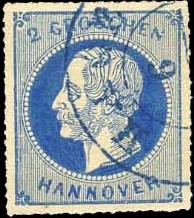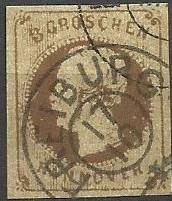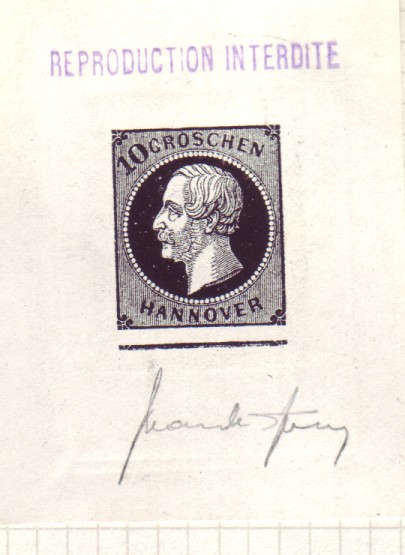




(Imperforate)
Return To Catalogue - Hanover 1850-1852 - 1853 Value and Crown issue - 1860 Horn and Crown issue - Cancels, Postal stationery - Hanover private issues (Mercur)
Note: on my website many of the
pictures can not be seen! They are of course present in the cd's;
contact me if you want to purchase them: evert@klaseboer.com.
30 Silbergroschen = 24 Gutegroschen = 1 Thaler
For other issues of Hanover (1853-1866) click here and here.



(Rouletted)
1 Groschen red 2 Groschen blue 3 Groschen yellow (orange) 3 Groschen brown (1861) 10 Groschen green (1861)
For the specialist: these stamps exists imperforated (1 g red, 2 g blue, 3 g brown, 3 g yellow, 10 g green) and rouletted (1 g red, 2 g blue and 3 g brown, 1864). The 2 g exists in a subtype with the bottom of the '2' curved (appears once on every sheet in the bottom left corner):

(Curved '2')
These stamps were issued after a currency change and they were issued on 15 February 1859. They were engraved by Mr. Brehmer and printed by Mr. Culemann in sheets of 120 stamps (12 rows of 10). The 1 g, 2 g and 3 g brown were issued in colors corrresponding to the German-Austrian Postal Union convention (the color of the 3 g yellow was intentionally changed from yellow to brown for this purpose).
Value of the stamps |
|||
vc = very common c = common * = not so common ** = uncommon |
*** = very uncommon R = rare RR = very rare RRR = extremely rare |
||
| Value | Unused | Used | Remarks |
Imperforate |
|||
| 1 g | * | * | |
| 2 g | *** | *** | |
| 3 g yellow | RR | *** | reprint: * |
| 3 g brown | *** | *** | reprint: * Issued 10th November 1861 to conform with
the color scheme used by the other members of the German-Austrian Postal Union. |
| 10 g green | RRR | RRR | Issued 1st March 1861. It could only be purchased in
the chief post offices, to be used on parcels or registered letters. |
| Rouletted (1864) | |||
| 1 g | *** | * | red or white gum |
| 2 g | R | *** | |
| 3 g | R | *** | with red gum: RR reprint: * |

(The sides of the sheets of these stamps contain numbers, the
so-called 'Reihenzähler')

1 g stamp from the bottom of a sheet with '1859' written in red;
I've also seen the year '1863' below a 1 g stamp.
It seems that a postal forgery of the 1 g imperforate stamp was made,only about three have survived. I do not have any further information.
I have also come across many 3 gr uncancelled stamps which are reprints (even multiples don't seem to be rare). These reprints are very difficult to distinguish according to 'An illustrated catalog of all known reprints of officially issued postage stamps and postal stationery, 1840 to 1892' by Kalckhoff, Hilckes and Evans. However, they are printed quite badly on thicker paper than the originals and can be recognized in this way. They were made by the printer C.Gerste in Hanover and sold by a Berlin stamp dealer (David Cohn) in 1891(?). Note the very thick line under the eye of the king. If they are perforated, the rouletted perforation is different from the genuine stamps (13 1/2 instead of 16). The 'Berliner Philatelisten-Klub' bought the printing materials used by Cohn in 1895 and donated them to the 'Reichpostmuseum' (source: http://www.berliner-philatelisten-klub-1888.de/hist.htm). Since the dies were defaced and subsequently repaired to make these reprints, some of the defacing lines can still be seen in the hair of the King (left next to the ear). These reprints must have been printed by millions, since they are still quite common today.

Defacing line which was not repaired going down in the three hair
lines to the left of the ear of the King.
Reprints also exist of the 2 gr value in black on four different paper colors (white, lilac, blue and brown). They were made in 1864 (see the Ohrt handbook). These official reprints are quite rare (much rarer than the above mentioned reprints).

1864 reprints in black on different coloured paper.


I've been told that this is another reprint, but I believe it
must be a forgery of the 2 g stamp. It is imperforate with very
large margins. I've seen other copies of this particular forgery
(only 2 g); their printing is very blur. It exists in at least
two different types.
Examples:
The above 2 g stamp is the second forgery described in Album Weeds (though Album Weeds only mentions the 1 g value of this particular forgery). There are many differences with the genuine stamp, but especially the differences in the eye and mustache can be seen immediatly. I think the 10 g stamps are made by the same forger. Note that in these stamps the '10' is smaller than in the genuine stamp and that the '1' is placed at a greater distance from the left border. I have seen the 10 g value cancelled with a large cancel consisting of 4 concentric circles (probably empty in the center). Also note the 'CORREOS 7.1.60. II-III' forged cancel, which usually appears on forgeries from South America.
The above stamp is a forgery of the 2 g with the bottom of the '2' curved. Note that the 'S' of 'GROSCHEN' has a very flat shape and the 'C' is misshapen when compared to a genuine stamp. Also, the letters 'NOV' of 'HANNOVER' are too close to the circle above them. The nose of the king is too flat. Next to it is a forgery of the 3 g value, probably made by the same forger. I've seen another copy of the 2 g forgery, with the same 'HANNOVER 13 7 8-9 A' double ring cancel. The block of four uncancelled 1 g stamps was also made by the same forger. Note the guidelines between the stamps, which do not appear on genuine stamps (the 2 g also has a guidenline at the left bottom hand side). These forgeries were possibly made by the Spiro brothers of Hamburg. These are possibly the first forgery type mentioned in Album Weeds.
Two forgeries of the 10 g value with the '10' too small (also made by Spiro?):


These two forgeries are believed to have been made by Spiro. The
first one has a 'HANNOVER' cancel in two concentric circles
without any date in black or blue color. The '10' is much too
small when compared to a genuine stamp. Note that on stamps with
large margins guidelines can be seen which do not appear on
genuine stamps. I've seen them with a one line 'FRA' (FRANCO?)
cancel.
Other forgeries
I've been told that the above stamps are forgeries. I have no further information on these stamps.

I've seen another forgery with exactly the same cancel. Besides
the cancel, the color appears to yellow.

(This forgery was made by Senf. It has a
'FALSCH' overprint)


Deceptive 10 g forgery. The left on has an 'Imit.' for
'Imitation' overprint. In the genuine stamp the internal part of
the '0' of '10' has two vertical frame lines missing at the left,
this forgery only misses one frameline. There is a space between
the pearls just above the left part of the 'V' of 'HANNOVER' in
this forgery. Also, the corner ornaments are smaller than the
genuine ones.

1 g green stamp; forgery.




2 g blue forgery with 'HAGE 6 2' cancel (most probably a Fournier
forgery) and a 3 g yellow Fournier forgery with 'HANNOVER 1 MAI
64' forged cancel. In my opinion, the '3' is badly done in the
second forgery. The third forgery has a 'FREIBURG 17 10' cancel
as can be found in the Fournier Album.
In the Fournier Album of Philatelic forgeries the values 1 g, 2 g and 3 g (brown?) , all imperforate, can be found as second choice forgeries. Fournier also offered a first choice forgery of the 10 g. In this 10 g Fournier forgery, the word 'HANNOVER' is printed rather badly. I've seen it with the cancel 'CHUTTORF 19 5' in blue (with the 'S' of Schuttorf missing?). These forgeries are not very common. Click here for more Fournier forgeries of Hannover.

Sperati forgeries:
Sperati made two forgeries of the 10 g value, some of them on genuine paper with genuine cancels (by removing the image of a lower valued stamp). The pictures were found on Richard Frajola's website: http://www.seymourfamily.com/rfrajola/Sperati/speratiindex.htm. Sperati forgeries are expensive and sought after in general. The differences with genuine stamps are often microscopic.


(Images obtained from Richard Frajola's website)


10 G Sperati reproduction A, there is a microscopic dot to the
right of the upper right corner ornament.

'Proof' of Sperati with violet 'REPRODUCTION INTERDITE' and
signature of Jean de Sperati

Pair of two Reproduction 'B' Sperati forgeries with 'DUDERSTADT 1
FEBR' cancel
Distinghuishing characteristics of the Sperati forgeries
Reproduction A
1) In the right corner ornament there are: a break in the upper
frameline, a white dot in the ornament in the extreme corner;
next to this there is a green dot.
2) There are weak spots in the circular frameline just below 'O'
and 'C' of 'GROSCHEN' and just above the pearls (covered by the
cancel in this case).
Reproduction B
1) The 'G' of 'GROSCHEN' is split (looks like a horn)
2) In the right upper corner, the lower curly ornament (the end
of the frameline) is also split.
The cancels used by Sperati are:
'NORDEN 1 11' in a double circle
'HANNOVER 20 4 BK NACHTS' in a double circle
'EMDEN 8.11 II HANNOVER' in three lines.
'DUDERSTADT 1 FEBR.' in two lines in a box (see the above pair)
'BLUMENTHAL 10 /2' in a double circle.
Other forgery:

(Stamp with a bogus 'star' cancel)

Essay in red, king in an ellipse, no value inscription. This is
probably an official reprint of the original essay. The reprint
was made in 1864 (see the Ohrt handbook on reprints). The
reprints were made in sheets(!). The reprints exist in the colors
black, red, blue, green and brown.